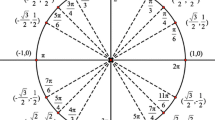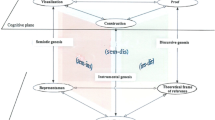Abstract
I discuss a teaching experiment that sought to characterize precalculus students’ angle measure understandings. The study’s findings indicate that the students initially conceived angle measures in terms of geometric objects. As the study progressed, the students formed more robust understandings of degree and radian measures by constructing an arc length image of angle measures; the students’ quantification of angle measure entailed measuring arcs and conceiving multiplicative relationships between a subtended arc, a circle’s circumference, and a circle’s radius. The students leveraged these quantitative relationships to transition between units with a fixed magnitude (e.g., an arc length’s measure in feet) and various angle measure units, while maintaining invariant meanings for angle measures in different units. These results suggest that quantifying angle measure, regardless of unit, through processes that involve measuring arc lengths can support coherent angle measure understandings.











Similar content being viewed by others
Notes
I use the term understanding to refer to a student's system of schemes and conceptual operations.
These studies did not investigate the teachers’ degree measure understandings.
For the purpose of this study, I define connected angle measure understandings as meanings that can be used to interpret angle measures in consistent ways regardless of the angle measure unit. Connected understandings of angle measure also enable students to flexibly convert between units of angle measure while maintaining these common meanings.
Values and numbers can be specified or unspecified. For instance, an individual can anticipate making or determining a measure and consider the meaning of this anticipated result independent of a specified value.
Judy and Zac are pseudonyms.
The results of these teaching sessions are part of a manuscript in preparation.
My use of the term calculational is consistent with the notion of a calculational orientation (Thompson, Philipp, Thompson, & Boyd, 1994), which describes an orientation towards identifying procedures, executing calculations, and working with numbers/expressions devoid of contextual reference.
I note that Zac did refer to a vague area or space between two rays during the interview, but this only occurred once.
To improve readability, I refer to the perimeter of the curved part of a protractor—a half circle—as the circumference of the protractor.
The students used the terms radians and radii (or radiuses) interchangeably when referencing any measure that involved measuring relative to a circle’s radius, even in the arbitrary case.
As an alternative to (c) and (d), the students also reasoned about multiplicatively comparing the arc length with the radius to determine the arc length in radii.
References
Akkoc, H. (2008). Pre-service mathematics teachers’ concept image of radian. International Journal of Mathematical Education in Science and Technology, 39(7), 857–878.
Bressoud, D. M. (2010). Historical reflections on teaching trigonometry. Mathematics Teacher, 104(2), 106–112.
Brown, S. A. (2005). The trigonometric connection: Students’ understanding of sine and cosine. Ph.D. dissertation, Illinois State University, USA.
Carlson, M., Jacobs, S., Coe, E., Larsen, S., & Hsu, E. (2002). Applying covariational reasoning while modeling dynamic events: A framework and a study. Journal for Research in Mathematics Education, 33(5), 352–378.
Carlson, M., Oehrtman, M., & Engelke, N. (2010). The precalculus concept assessment (PCA) instrument: A tool for assessing reasoning patterns, understandings, and knowledge of precalculus level students. Cognition and Instruction, 28(2).
Castillo-Garsow, C. C. (2010). Teaching the Verhulst model: A teaching experiment in covariational reasoning and exponential growth. Ph.D. dissertation, Arizona State University Tempe.
Clement, J. (2000). Analysis of clinical interviews: Foundations and model viability. In A. E. Kelly & R. A. Lesh (Eds.), Research design in mathematics and science education (pp. 547–589). Mahwah: Lawrence Erlbaum Associates, Inc.
Clements, D. H., & Burns, B. A. (2000). Students’ development of strategies for turn and angle measure. Educational Studies in Mathematics, 41(1), 31–45.
Ellis, A. B. (2007). The influence of reasoning with emergent quantities on students’ generalizations. Cognition and Instruction, 25(4), 439–478.
Fi, C. (2003). Preservice secondary school mathematics teachers’ knowledge of trigonometry: Subject matter content knowledge, pedagogical content knowledge and envisioned pedagogy. Ph.D. dissertation, University of Iowa, USA.
Goldin, G. A. (2000). A scientific perspective on structured, task-based interviews in mathematics education research. In A. E. Kelly & R. A. Lesh (Eds.), Research design in mathematics and science education (pp. 517–545). Mahwah: Lawrence Erlbaum Associates, Inc.
Johnson, H. L. (2012). Reasoning about variation in the intensity of change in covarying quantities involved in rate of change. The Journal of Mathematical Behavior, 31(3), 313–330.
Kieran, C. (1986). LOGO and the notion of angle among fourth and sixth grade children. In L. Burton & C. Hoyles (Eds.), Proceedings of the 10th International Conference on the Psychology of Mathematics Education (pp. 99–104). London: City University.
Matos, J. (1990). The historical development of the concept of angle. The Mathematics Educator, 1(1), 4–11.
Mitchelmore, M. C., & White, P. (2000). Development of angle concepts by progressive abstraction and generalization. Educational Studies in Mathematics, 41(3), 209–238.
Moore, K. C., & Carlson, M. P. (2012). Students’ images of problem contexts when solving applied problems. The Journal of Mathematical Behavior, 31(1), 48–59.
Moore, K. C., LaForest, K., & Kim, H. J. (2012). The unit circle and unit conversions. In S. Brown, S. Larsen, K. Marrongelle, & M. Oehrtman (Eds.), Proceedings of the Fifteenth Annual Conference on Research in Undergraduate Mathematics Education (pp. 16–31). Portland: Portland State University.
Smith, J., III, & Thompson, P. W. (2008). Quantitative reasoning and the development of algebraic reasoning. In J. J. Kaput, D. W. Carraher, & M. L. Blanton (Eds.), Algebra in the early grades (pp. 95–132). New York: Lawrence Erlbaum Associates, Inc.
Steffe, L. P., & Thompson, P. W. (2000). Teaching experiment methodology: Underlying principles and essential elements. In A. E. Kelly & R. A. Lesh (Eds.), Research design in mathematics and science education (pp. 267–307). Mahwah: Lawrence Erlbaum Associates, Inc.
Strauss, A. L., & Corbin, J. M. (1998). Basics of qualitative research: Techniques and procedures for developing grounded theory (2nd ed.). Thousand Oaks: Sage.
Thompson, P. W. (1990). A theoretical model of quantity-based reasoning in arithmetic and algebra. San Diego: Center for Research in Mathematics & Science Education, San Diego State University.
Thompson, P. W. (1994). Images of rate and operational understanding of the fundamental theorem of calculus. Educational Studies in Mathematics, 26(2–3), 229–274.
Thompson, P. W. (2008). Conceptual analysis of mathematical ideas: Some spadework at the foundations of mathematics education. In O. Figueras, J. L. Cortina, S. Alatorre, T. Rojano, & A. Sépulveda (Eds.), Proceedings of the Annual Meeting of the International Group for the Psychology of Mathematics Education (Vol. 1, pp. 45–64). Morélia: PME.
Thompson, P. W. (2011). Quantitative reasoning and mathematical modeling. In S. Chamberlin, L. L. Hatfield, & S. Belbase (Eds.), New perspectives and directions for collaborative research in mathematics education: Papers from a planning conference for WISDOM^e. Laramie: University of Wyoming.
Thompson, P. W., Carlson, M. P., & Silverman, J. (2007). The design of tasks in support of teachers’ development of coherent mathematical meanings. Journal of Mathematics Teacher Education, 10, 415–432.
Thompson, A. G., Philipp, R. A., Thompson, P. W., & Boyd, B. A. (1994). Calculational and conceptual orientations in teaching mathematics. In A. Coxford (Ed.), 1994 yearbook of the NCTM (pp. 79–92). Reston: NCTM.
Topçu, T., Kertil, M., Akkoc, H., Kamil, Y., & Osman, Ö. (2006). Pre-service and in-service mathematics teachers’ concept images of radian. In J. Novotná, H. Moraová, M. Krátká, & N. Stehlíková (Eds.), Proceedings of the 30th Conference of the International Group for the Psychology of Mathematics Education (Vol. 5, pp. 281–288). Prague: PME.
Weber, K. (2005). Students’ understanding of trigonometric functions. Mathematics Education Research Journal, 17(3), 91–112.
Acknowledgments
National Science Foundation (NSF) grant number EHR-0412537, led by the principal investigator Marilyn Carlson, supported this work. All opinions expressed are solely those of the author and do not necessarily reflect the views of the NSF. I thank Marilyn Carlson, Andrew Izsák, and the reviewer team for providing feedback on previous versions of this article. I also thank Pat Thompson for his substantive conversations about angle measure and quantitative reasoning. These conversations have undoubtedly influenced my thinking on these topics and shaped the study.
Author information
Authors and Affiliations
Corresponding author
Rights and permissions
About this article
Cite this article
Moore, K.C. Making sense by measuring arcs: a teaching experiment in angle measure. Educ Stud Math 83, 225–245 (2013). https://doi.org/10.1007/s10649-012-9450-6
Published:
Issue Date:
DOI: https://doi.org/10.1007/s10649-012-9450-6




